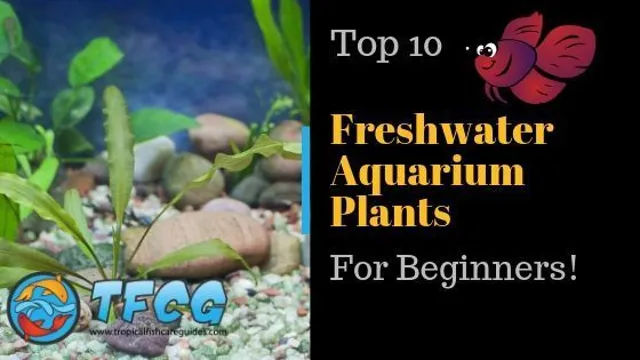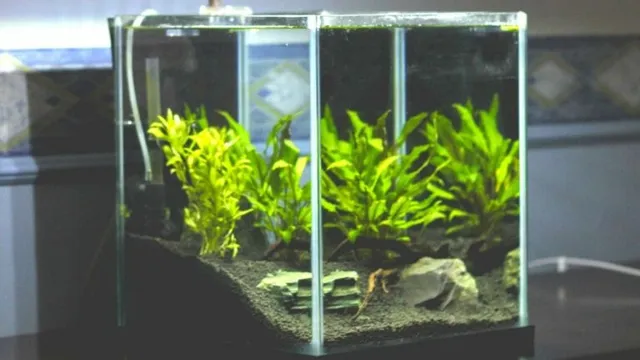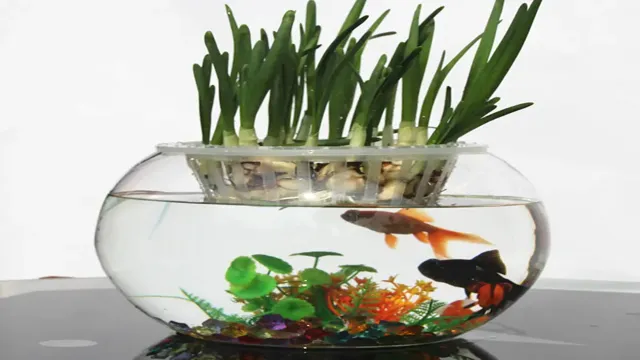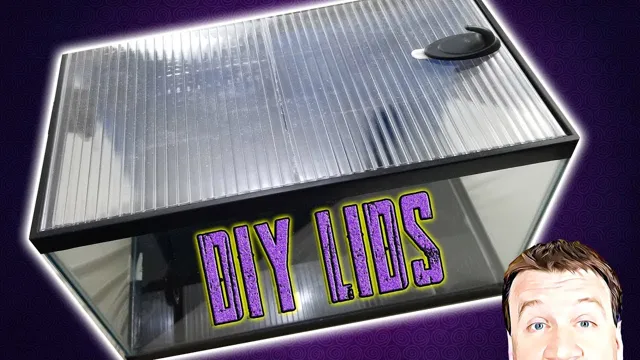How to Keep Aquarium Plants Low CO2: Tips and Tricks.

Aquatic plants not only enhance the aesthetic appeal of our aquariums, but they also play a vital role in maintaining a healthy aquatic environment. However, many aquarium enthusiasts shy away from owning live plants due to the apparent complexity of keeping them alive. One common misconception is that flourishing aquarium plants require a high amount of carbon dioxide (CO2).
While CO2 is essential to plant growth, it is not necessarily a requirement for a lush and healthy aquarium. In this blog, we will explore different ways to keep aquarium plants without adding CO2, addressing some common misconceptions and sharing tips for a thriving plant ecosystem in your aquarium. So, let’s dive in and uncover the secrets of keeping aquarium plants low CO2!
Understanding CO2 Levels in Aquariums
If you’re an aquarium enthusiast, you probably know that aquatic plants play a crucial role in maintaining a healthy aquarium ecosystem. However, it’s important to keep the carbon dioxide (CO2) levels in check to ensure the adequate growth of plants without harming the aquatic animals. So, how to keep aquarium plants low CO2? One effective method is to inject CO2 into the aquarium water using a CO2 diffuser.
This will help regulate the CO2 levels in the water, allowing plants to thrive while maintaining the health of aquatic animals. You can also install a pH controller to monitor the CO2 levels and ensure they remain within a healthy range. Another way to minimize CO2 levels is to avoid overcrowding the aquarium with too many plants.
When there are too many plants, they can absorb excessive amounts of CO2, making it difficult for fish and other animals to breathe. By keeping a check on CO2 levels, you can ensure that your aquarium plants remain healthy and vibrant without harming the overall ecosystem.
CO2 Sources in Aquariums
CO2 levels in aquariums can be crucial for the health and success of aquatic life. Understanding where CO2 comes from and how it affects the aquarium environment is important for any hobbyist. The most common source of CO2 in aquariums is through the respiration of aquatic plants and fish.
As fish and plants consume oxygen, they release CO2 back into the water. Another source of CO2 is through decaying organic matter, which can lead to an increase in CO2 levels and a decrease in oxygen levels if not properly managed. It is important to monitor and maintain the right CO2 levels to promote optimal growth and health in your aquatic plants and fish.
Utilizing CO2 injection systems can also help to regulate CO2 levels in larger aquariums. Overall, understanding CO2 sources in aquariums can lead to a better understanding of the overall aquarium environment and lead to healthier and happier aquatic life.

Optimal CO2 Levels for Low-Light Plants
CO2 levels in aquariums. If you’re into aquariums, you may have heard about the importance of maintaining optimal CO2 levels in order to keep low-light plants healthy and beautiful. But what exactly are those optimal levels, and why do they matter? CO2 is a vital nutrient for aquatic plants, and without it, they can’t perform photosynthesis effectively, which means they won’t be able to grow and thrive.
However, too much CO2 can also be harmful, as it can lower the pH levels of the water and create conditions that are stressful for fish and other aquatic creatures. The ideal CO2 levels for low-light plants are between 15-30 ppm (parts per million), which ensures that they have enough carbon dioxide to grow and stay healthy, while also maintaining a safe and stable environment for all the inhabitants of the tank. So if you want your aquarium plants to flourish, it’s important to keep a close eye on their CO2 levels and make any necessary adjustments to ensure they’re getting what they need.
Choosing the Right Plants
When it comes to keeping aquarium plants low co1, choosing the right plants is key. Not all plants are created equal in terms of their carbon dioxide (CO1) requirements, and it’s important to select plants that will thrive with the amount of CO1 available in your tank. Some good options for low CO1 environments include Java fern, Anubias, and mosses like Christmas and Java moss.
These plants have the ability to effectively absorb the limited CO1 available, and will still provide beautiful and healthy greenery for your aquarium. Additionally, they are easy to care for and require minimal maintenance, making them a great choice for beginners. By selecting the right plants for your low CO1 environment, you can ensure a thriving and picturesque aquascape.
Low CO2-Tolerant Plants
When it comes to gardening, selecting the right plants is crucial, especially if you wish to have a sustainable garden with less dependence on fertilizers and other chemicals. Low CO2-tolerant plants are a great option for those who want to reduce their carbon footprint. These plants are capable of thriving in environments with lower levels of CO2 and usually require less maintenance.
However, when choosing the right low CO2-tolerant plant, it’s important to consider your region, soil type, and available sunlight. Some examples of low CO2-tolerant plants include lavender, mint, daisies, and marigolds. These plants not only absorb CO2 but also release oxygen, improving the air quality in your surrounding areas. (See Also: How to Clean Water Stains on Fish Aquarium: Tips and Tricks for Sparkling Clean Tanks)
Moreover, these plants require less watering, which is beneficial for water conservation. By opting for low CO2-tolerant plants, you can make a positive impact on the environment while beautifying your space.
Plant Placement and Arrangement
When it comes to plant placement and arrangement, choosing the right plants is crucial. It’s important to consider factors such as the amount of sunlight and water each plant needs, as well as the overall aesthetic you want to achieve. Before you start planting, take some time to research which plants are best suited to your specific growing conditions.
Think about the colors, textures, and heights of each plant and how they will complement one another in your chosen space. It’s also a good idea to consider the long-term growth patterns of each plant, so you can ensure that they won’t crowd each other out as they mature. By carefully choosing the right plants for your garden, you can create a beautiful and balanced landscape that thrives for years to come.
Effective Plant Pruning Techniques
When it comes to effective plant pruning techniques, one of the most important things to consider is choosing the right plants in the first place. Some plants are simply easier to prune and maintain than others, so it’s important to choose plants that are well-suited to your pruning skills and schedule. For beginners, it’s a good idea to start with low-maintenance plants that don’t require too much pruning or specialized care.
Consider plants like shrubs, perennials, or evergreens, which tend to be fairly resilient and easy to work with. On the other hand, some plants like roses, fruit trees, or topiaries require a lot more attention and expertise when it comes to pruning. By choosing plants that fit your skill level and lifestyle, you’ll be more likely to achieve the desired results and avoid any headaches along the way.
Remember, pruning is all about removing the right branches at the right time to promote healthy growth and shape your plants, so choose wisely and enjoy the process!
Implementing CO2 Injection Systems
Keeping aquarium plants low on CO2 can be a real challenge for many aquatic pet owners. However, with the implementation of CO2 injection systems, maintaining a healthy, thriving aquatic plant environment is certainly achievable. In order to implement a CO2 injection system, it’s important to first analyze your aquarium’s size and needs.
From there, you can determine the appropriate amount of CO2 to inject into your water. Certain aquarium plants may also require more or less CO2, so researching the individual needs of your plant species is key. Once you have the necessary equipment and knowledge, setting up the CO2 injection system is a relatively simple process.
By providing the right amount of CO2 and maintaining a balanced environment, your aquarium plants will be able to thrive, creating a beautiful and healthy aquatic ecosystem for your pets to enjoy.
Types of CO2 Injection Systems
CO2 injection systems are an effective way of mitigating the harmful effects of greenhouse gases on the environment. There are different types of CO2 injection systems, each with its unique features and benefits. One of the most common types is the subterranean CO2 injection system, where carbon dioxide is injected into geological formations deep beneath the earth’s surface.
This type of injection has been used for years in Enhanced Oil Recovery (EOR) operations and is gaining popularity as a means of carbon capture and storage. Another type of CO2 injection system is the oceanic system, where CO2 is injected into the deep ocean layers. This technique has the potential of sequestering large amounts of CO2 over long periods.
However, it is still in the experimental phase, and environmental impacts are yet to be fully investigated. Another type of system is the terrestrial system, where carbon dioxide is injected directly into the soil. This type of system has shown promise in enhancing soil fertility, reducing greenhouse gas emissions from farming, and carbon sequestration.
Overall, CO2 Injection Systems have proven to be an effective way of reducing the amount of carbon dioxide in the atmosphere, making them valuable tools in the fight against climate change. (See Also: How to Clear Up Foggy White Aquarium Water in 7 Easy Steps – SEO optimized title.)
Proper Placement and Maintenance
When it comes to implementing CO2 injection systems in your aquarium, proper placement and maintenance are key. It’s important to place your injection system in an area where there is good water flow and distribution. This will help ensure that the CO2 is evenly distributed throughout the tank and that your plants receive the necessary amount for optimal growth.
Additionally, regular maintenance is crucial to the success of your CO2 injection system. You’ll need to monitor and adjust the CO2 levels as needed, clean and replace the diffuser or reactor regularly, and ensure that your CO2 tank is always full. By taking these small steps, you’ll be able to keep your aquarium healthy and thriving, and your plants will flourish in the optimal environment.
Factors Affecting CO2 Levels in Aquariums
As an aquarium enthusiast, one of the things that you need to keep in mind is the CO2 levels in your aquarium. Maintaining low CO2 levels is essential for the healthy growth of your aquarium plants. Several factors can affect the CO2 levels in your aquarium.
One of the significant factors is the size of your aquarium. The larger your aquarium, the more volume of water it has, and the more diluted your CO2 levels will be. Another factor is the type of filter you use.
Some filters cause more oxygen exchange, which can lead to lower CO2 levels. Additionally, the number of plants in your aquarium can affect CO2 levels. More plants mean higher oxygen demand and lower CO2 levels.
Finally, factors like lighting and water flow can also affect CO2 levels. In summary, keeping your aquarium plants’ CO2 levels low can be achieved by considering these factors and ensuring the right balance of oxygen and carbon dioxide.
Avoiding Overcrowding and Overfeeding
CO2 levels in aquariums If you’re an aquarium hobbyist, then you might be familiar with the role CO2 plays in keeping your aquatic ecosystem healthy. CO2 levels are critical in preventing overcrowding and overfeeding in your aquarium. Factors such as the number of fish, the type of plants you have, and the lighting used can all affect CO2 levels.
Overcrowding occurs when there are too many fish in the tank for the amount of water available, leading to a buildup of CO2 and other waste products. Overfeeding can also contribute to high CO2 levels since extra food will decay and produce carbon dioxide. It is important to maintain appropriate CO2 levels in your aquarium to ensure the fish and plants can thrive.
A high level of CO2 can lead to reduced oxygen levels and even death for your fish. A low level of CO2 can stunt the growth of your plants and affect their ability to photosynthesize. Regular monitoring of your aquarium’s CO2 levels is essential, and you can use a CO2 test kit to measure these levels.
Additionally, you can add plants that will naturally help regulate CO2 levels by absorbing excess carbon dioxide and releasing oxygen into the water. By taking all these measures, you can create an environment that is balanced, healthy, and ideal for fish and plants alike.
Maintaining Proper Water pH and Hardness
Maintaining Proper Water pH and Hardness in an aquarium is crucial for the health of your fish and plants. One important factor that affects CO2 levels in your aquarium is water agitation. When water is agitated, it creates surface tension which allows for better CO2 exchange.
This is important because fish and plants require a certain amount of CO2 for their survival. Additionally, the amount of light your aquarium receives can also affect CO2 levels. When there is a lot of light, plants tend to use more CO2 for photosynthesis.
This can cause the pH level to drop, making the water more acidic. Another factor that affects CO2 levels is the number of fish in your aquarium. Fish produce CO2 through respiration, so a heavily stocked aquarium may have higher CO2 levels. (See Also: How to Make Fake Aquarium Plants: A Step-by-Step Guide for Stunning Underwater Décor)
It is important to monitor your aquarium’s pH and hardness levels regularly and make necessary adjustments to ensure your aquatic ecosystem stays healthy.
Conclusion and Further Tips
In conclusion, keeping aquarium plants low CO1 can be achieved through a bit of science and a touch of creativity. Firstly, by understanding the importance of CO2 injection and circulation, plant growth can be boosted while avoiding the negative effects of CO1 accumulation. Secondly, planting low-maintenance aquarium plants that thrive in low CO1 environments can keep your tank looking lush and green without the need for excessive CO2 supplementation.
In essence, finding the right balance of CO2 and plant selection is the key to creating a beautiful and healthy aquarium ecosystem. So don’t be intimidated by the science – just remember to let your creativity and love for aquatic life guide you!”
FAQs
What is low CO2 aquarium plant growth?
Low CO2 aquarium plant growth refers to maintaining aquarium plants in an environment with low levels of carbon dioxide.
Can aquarium plants survive without CO2 injection?
Yes, aquarium plants can survive without CO2 injection, but they may grow at a slower rate and not be as vibrant in color.
How can I maintain low CO2 levels in my aquarium for plant growth?
You can maintain low CO2 levels in your aquarium by limiting the amount of fish and avoiding overfeeding, using low-light plants, and reducing surface agitation.
What are some benefits of using low CO2 plants in my aquarium?
Some benefits of using low CO2 plants in your aquarium include lower maintenance and equipment costs, easier plant care, and a more natural, low-tech setup.
Do I need special lighting for low CO2 plants?
No, low CO2 plants do not require special lighting. They can thrive with moderate to low lighting.
Can low CO2 plants be used in a high-tech aquarium setup?
Yes, low CO2 plants can be used in a high-tech aquarium setup, but they will require more fertilization and maintenance.
How can I ensure proper nutrient levels for low CO2 plants?
You can ensure proper nutrient levels for low CO2 plants by using a high-quality substrate and regularly dosing with liquid fertilizers and root tabs.






